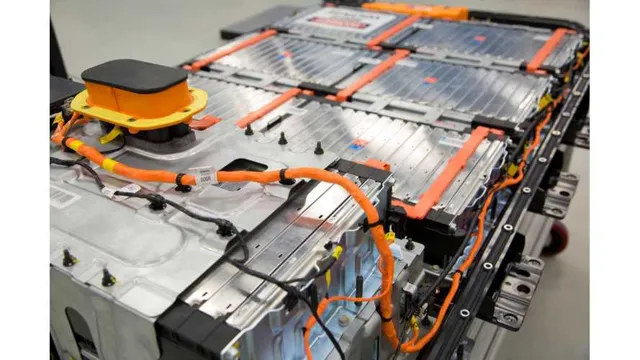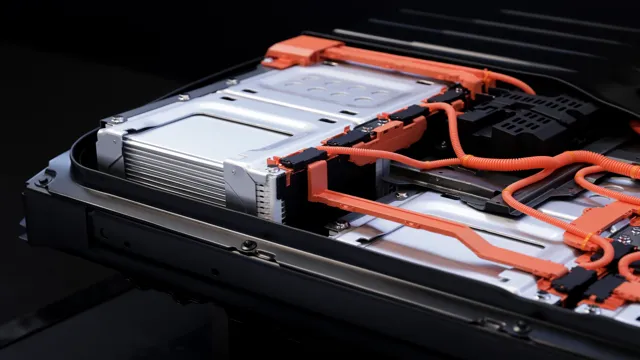Decoding the Carbon Footprint of Electric Car Batteries: Separating Myth from Reality
Electric cars are often touted as a more eco-friendly alternative to traditional gasoline-powered vehicles. However, it’s important to understand the environmental impact of electric cars’ batteries, specifically their carbon footprint. While electric cars do produce significantly less greenhouse gas emissions during their operation than their gasoline counterparts, the production of an electric car battery requires a considerable amount of energy and resources.
In this blog, we’ll dive into the carbon footprint of electric car batteries and explore the environmental implications of this component of electric vehicles.
Introduction
Electric cars have emerged as a more environmentally friendly alternative to gasoline-powered cars. However, a major concern among drivers is the carbon footprint of the electric car battery itself. The production of electric car batteries requires a significant amount of energy and resources, which can result in a high carbon footprint.
While the exact carbon footprint varies depending on the manufacturer and the composition of the battery, studies suggest that the production of a typical electric car battery emits between 150 and 200 kg of carbon dioxide. It should be noted, however, that while the production process may result in a higher initial carbon footprint, it is significantly offset by the reduced emissions and environmental impact of driving an electric car. Additionally, manufacturers are working to improve the production process and make it more sustainable, which will further reduce the carbon footprint of electric car batteries in the future.
Defining carbon footprint in context of electric car battery
If you’re considering buying an electric car, you may have come across the term “carbon footprint” in relation to the battery. But what exactly does this mean? Well, a carbon footprint is essentially the total amount of greenhouse gases produced by a certain activity, such as driving a car or manufacturing a product. In the case of an electric car battery, the carbon footprint refers to the amount of emissions released during the production and disposal of the battery, as well as the electricity used to power the car.
It’s worth noting that the carbon footprint of an electric car battery can vary depending on factors such as the materials used, the manufacturing process, and the source of the electricity used to charge the battery. Despite this, electric cars generally have a lower carbon footprint than traditional petrol or diesel cars, making them a more environmentally friendly choice.
Why is measuring carbon footprint of electric car battery important?
Measuring the carbon footprint of electric car batteries is incredibly important for a variety of reasons. One of the most significant reasons is that it helps us to understand the overall sustainability of electric vehicles and how they compare to traditional gasoline-powered vehicles. By understanding the entire lifecycle of an electric car battery, including the manufacturing process, the use of the vehicle, and what happens to the battery at the end of its life, we can determine the carbon emissions associated with it.
This information is crucial for policymakers, manufacturers, and consumers alike as they work to reduce their carbon footprint and make more environmentally-friendly choices. By emphasizing the importance of measuring the carbon footprint of electric car batteries, we can ensure that we are taking the necessary steps towards a cleaner and greener future.
What is the carbon footprint of an electric car battery?
As electric cars become increasingly popular, many people are curious about their environmental impact. One frequently asked question is: What is the carbon footprint of an electric car battery? While the carbon footprint of an electric car battery is generally lower than that of a gasoline-powered car, it still requires a significant amount of energy and resources to produce. The production process involves mining raw materials like lithium, cobalt, and nickel, which can lead to environmental degradation and carbon emissions.
However, the long-term benefits of electric cars can outweigh the initial carbon footprint of the battery. Electric cars produce zero emissions during operation, which can significantly reduce the overall carbon emissions and air pollution caused by transportation. Additionally, as renewable energy sources become more prevalent, the carbon footprint of electric car batteries will continue to decrease.
Breaking down the manufacturing process of electric car battery
The manufacturing process of an electric car battery involves multiple stages, starting from the extraction of raw materials to the final assembly of the battery. The raw materials used in the manufacturing process include lithium, cobalt, nickel, and manganese; these materials are mined, processed, and transported from different regions around the world, adding to the carbon footprint of the battery. Once the raw materials are extracted and processed, they are combined and assembled into battery cells.
These cells are then connected to form battery packs that power the electric car. When considering the carbon footprint of an electric car battery, it is essential to consider not only the manufacturing process but also the energy consumed during the battery’s life cycle. Although the production of an electric car battery has an environmental impact, electric cars remain a more sustainable alternative to traditional gasoline-powered cars, as they emit fewer greenhouse gases and produce less pollution.
Therefore, promoting the adoption of electric cars could significantly reduce the carbon footprint of the transportation sector.
Impact of the raw materials for electric car batteries
The carbon footprint of electric car batteries has been a topic of discussion in recent years. One of the primary raw materials used in these batteries is lithium, which is mined in countries like Bolivia and Chile. Mining of lithium has raised concerns regarding its environmental impact, as it can lead to deforestation and the destruction of ecosystems.
Additionally, the transportation of these materials and the production of batteries result in greenhouse gas emissions. However, it is important to note that electric vehicles still have a significantly lower carbon footprint than traditional gasoline-powered vehicles, even when considering the production and disposal of batteries. As the use of renewable energy sources increases, the carbon footprint of electric cars will continue to decrease.
Energy used in electric car battery manufacturing facilities
When it comes to electric car battery manufacturing, it’s natural to wonder about the carbon footprint of the process. The energy used in these facilities can have a significant impact on the environment. However, there is good news for those concerned about the carbon footprint of electric vehicles.
Over the years, many automakers have made efforts to reduce their environmental impact by investing in renewable energy sources such as wind and solar power. Additionally, many companies are prioritizing materials that are more sustainable and environmentally friendly. As an example, Tesla has recently announced plans to eliminate cobalt from its batteries, which is often sourced from problematic mines.
When it comes to the carbon footprint of electric car battery manufacturing, there is much to be optimistic about as the industry continues to prioritize sustainability and renewable energy.
Comparing carbon footprint of electric car battery to traditional car
When it comes to comparing the carbon footprint of electric car batteries to traditional car engines, it’s important to consider a variety of factors. Firstly, electric cars produce zero emissions while driving, which is a big plus for the environment. However, the production of batteries for electric cars can result in a larger carbon footprint than traditional car engines.
This is due to the materials used in the battery production process, including the mining of rare metals such as lithium and cobalt. Additionally, the transportation and disposal of electric car batteries can also contribute to their overall carbon footprint. On the other hand, traditional car engines have higher emissions while driving, but the production process is typically less carbon-intensive.
Ultimately, the carbon footprint of an electric car battery versus a traditional car engine will depend on several factors, including the manufacturer and production process used. However, it’s clear that electric cars have the potential to greatly reduce carbon emissions in the long run.
Data comparison between carbon emissions of traditional and electric car
Electric car vs traditional car carbon emissions
— When it comes to comparing the carbon footprint of electric cars and traditional cars, there’s a lot to consider. One of the most significant factors is the battery in electric cars, which has long been a concern for those worried about the environmental impact of these vehicles. However, when you take a closer look at the numbers, electric cars are still a far better choice for the environment than their traditional counterparts.
In fact, according to the Union of Concerned Scientists, the average electric car produces half the emissions of a traditional car over its lifetime, even when you take into account the production of the battery. This is because electric cars run on clean electricity, which produces far fewer emissions than the gasoline used in traditional cars. So while the battery in an electric car does have an environmental impact, it’s a small price to pay for the massive benefits that electric cars can provide in reducing carbon emissions and fighting climate change.
Factors that impact the carbon footprint of electric car battery compared to traditional car
When considering the carbon footprint of electric car batteries compared to traditional cars, it’s important to take a few factors into account. Firstly, the sourcing of the materials used to make the battery plays a big role. Battery materials such as lithium and cobalt are often mined in countries with weak environmental regulations, resulting in significant carbon emissions during the extraction process.
Additionally, the manufacturing process of the battery is energy-intensive, consuming a considerable amount of electricity. However, once the battery is in the car, it’s a whole other story. Electric cars produce no emissions during driving, which is a significant advantage over traditional cars.
If the electricity used to charge the car comes from renewable sources, the overall carbon footprint of an electric car battery is considerably lower than a traditional car. The key is to ensure that the materials and manufacturing methods used in battery production are as sustainable as possible, and that renewable sources power the electricity supply.
Reducing carbon footprint of electric car battery
As the world shifts towards renewable energy sources, electric vehicles are becoming an increasingly popular mode of transportation. However, concerns have been raised about the carbon footprint of electric car batteries. The production and disposal of these batteries emit large amounts of carbon dioxide, which contributes to climate change.
To reduce the carbon footprint of electric car batteries, researchers are exploring different approaches. One solution is to use more sustainable materials, such as recycled metals, in the production process. Another approach is to develop more efficient manufacturing methods that require less energy and produce less waste.
Additionally, improving battery recycling programs can help reduce the environmental impact of battery disposal. By implementing these strategies, we can take steps towards reducing the carbon footprint of electric car batteries and creating a more sustainable future.
Exploring ways to reduce carbon footprint of electric car battery production and disposal
Electric car batteries are a crucial component of any electric car, as they provide the power necessary to run the car’s motor. Unfortunately, the production and disposal of these batteries can have a significant environmental impact. To reduce the carbon footprint of electric car battery production and disposal, we need to explore various measures.
Firstly, we can reduce the use of rare earth metals and other materials used in battery production, which are often sourced through environmentally harmful practices. Recycling of materials like lithium, cobalt, and nickel, which are commonly used in these batteries, can also help to reduce waste and carbon emissions. Additionally, using renewable energy sources during the production process can have a significant impact in reducing greenhouse gas emissions.
We can also improve the longevity of batteries through better design, making it possible to use them for longer periods of time before the need for replacement arises. By taking these measures collectively, we can significantly reduce the carbon footprint of electric car battery production and disposal and make electric cars a more sustainable form of transportation.
Conclusion
In conclusion, the concept of the carbon footprint of an electric car battery is perhaps best compared to a game of chess. Just like in chess, every move we make has ripple effects on the board, and we must constantly be conscious of the long-term consequences of our next move. Similarly, while an electric car battery may appear to be a green choice at first glance, we must also consider the impact of the production of the battery materials, as well as the energy sources used to power the car.
By playing our cards right and taking a holistic approach, we can ensure that the carbon footprint of electric car batteries remains in check and contributes toward a more sustainable future.
FAQs
What is the carbon footprint of an electric car battery?
The carbon footprint of an electric car battery varies based on several factors such as the location of manufacturing, energy sources used during manufacturing and the size of the battery.
How does the carbon footprint of an electric car battery compare to a traditional car’s carbon footprint?
The carbon footprint of an electric car battery can be significantly lower than a traditional car’s carbon footprint, especially if the battery is manufactured using renewable energy sources.
Can the carbon footprint of an electric car battery be offset by using renewable energy to charge it?
Yes, the carbon footprint of an electric car battery can be offset by using renewable energy sources such as solar or wind energy to charge it.
Are there any initiatives to reduce the carbon footprint of electric car batteries?
Yes, there are initiatives to reduce the carbon footprint of electric car batteries such as using recycled materials in the manufacturing process and developing more sustainable battery chemistries.




